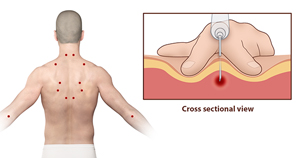Trigger Point Injections

Trigger points are tight bands or knots that form when a muscle fails to relax after a contraction. These areas of pain and muscle spasm may develop due to acute trauma, overuse injuries or chronic muscular disorders. They usually occur in the upper back and shoulder muscles and may irritate adjacent nerves causing pain to radiate to the surrounding regions. Trigger point injections or TPI may contain an anesthetic, steroid or a combination of the two. They are administered to relieve pain and improve mobility.
Indications
Trigger point injections are administered to relieve intense pain at the trigger points and surrounding areas. They can be used in the management of conditions such as fibromyalgia, tension headaches, temporomandibular pain and myofascial pain syndrome.
Procedure
The trigger point is usually located by palpation, but an ultrasound localization technique may also be used. A topical anesthetic may be applied to numb the area and keep you comfortable during the procedure. Then a small injection containing local anesthetic with or without corticosteroid is directly administered to the trigger point making it inactive and relieving pain.
If you are allergic to the anesthetic, your doctor may use a dry-needle technique where a needle is inserted into the trigger point, but no medication is used. This can also relieve pain. The procedure takes just a few minutes.
A single injection may be enough to treat trigger points due to trauma or repetitive use injuries. Chronic conditions usually require periodic administration of trigger point injections.
Post-Operative Care
You will experience some numbness at the site for approximately an hour. You may also develop some pain and bruising at the injection site. Hot or cold packs and over the counter pain medication can help relieve these symptoms. Stretching and other physical therapy exercises are usually recommended after trigger point injections.
Risks and complications
As with any injection, there is a risk of infection or bleeding. Rarely, you may experience an indentation of the skin due to shrinkage of fat when a steroid is administered.







